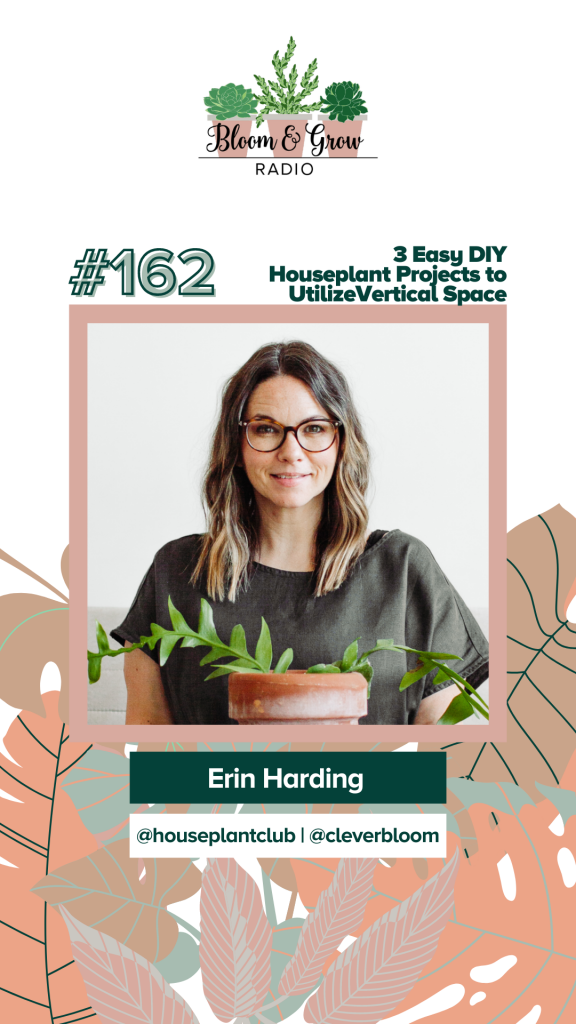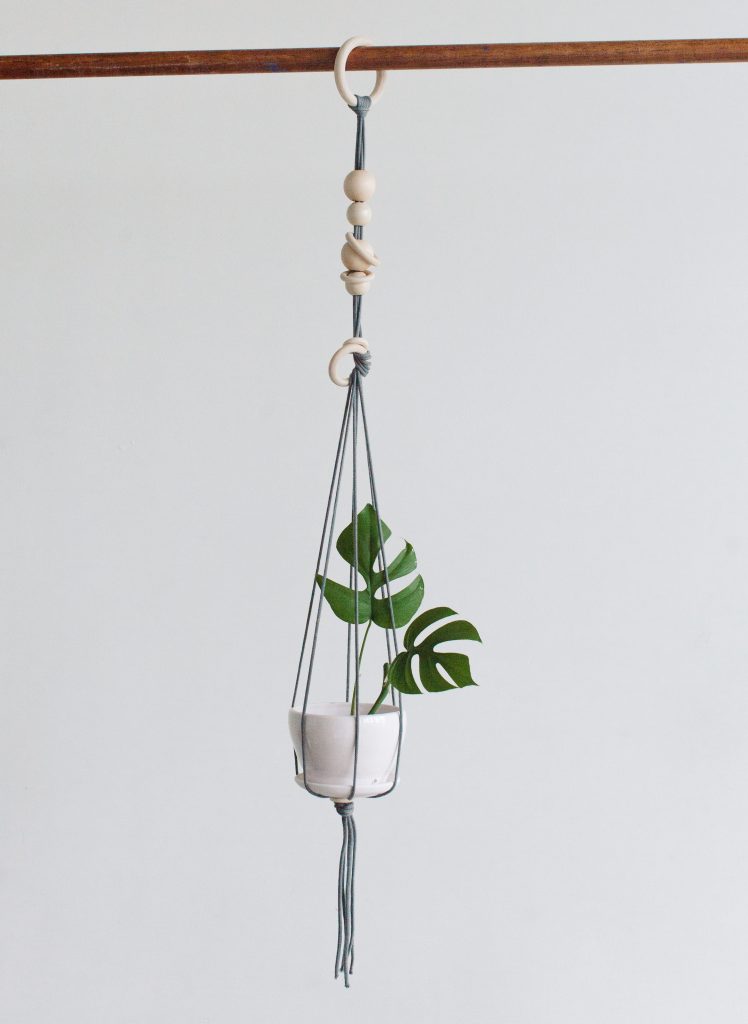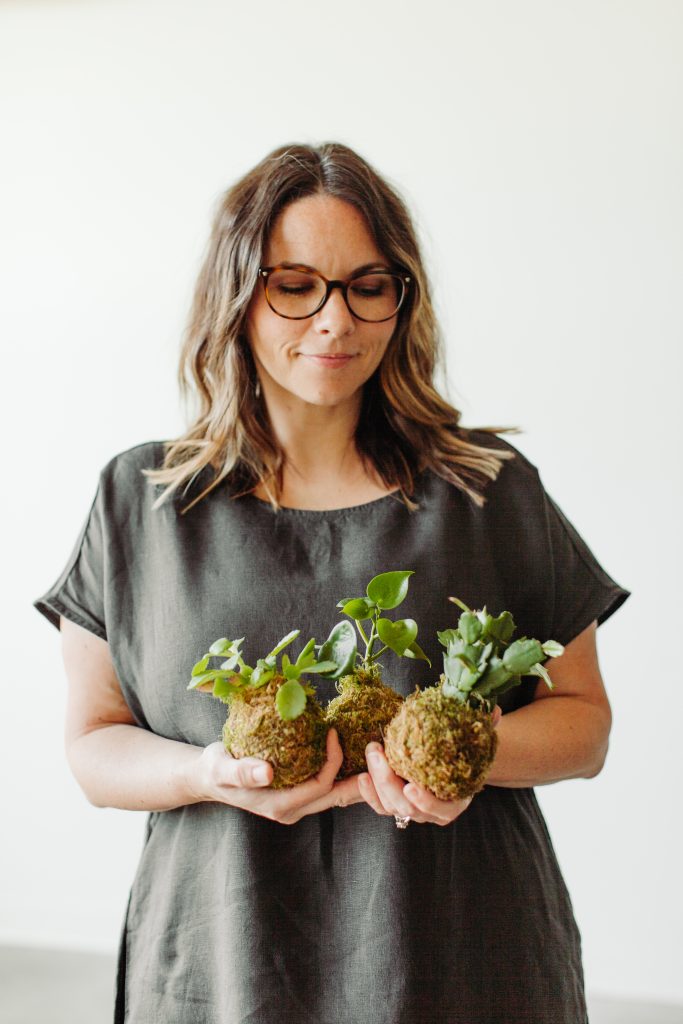Welcome to the Growing Joy Blog!
Check out our Product Reviews, DIY tutorials, Garden to Table Recipes, podcast show notes, and more!
advanced plant care, General Plant Care Guides, Individual Plant Care Guides, indoor plants, plant care, plant propagation, Planty People, podcast
3 Easy DIY Houseplant Projects to Utilize Vertical Space with Erin of @houseplantclub and @cleverbloom , Ep 161

Are you running out of space for your plants? Growing your plant collection can be quite the challenge when all your countertops, tablespace and even floorspace have been populated with your plant babies. Don’t fret any longer, plant friends, as we got the most beautiful and mess-free DIY projects for you to make the most out of your vertical space at home! In this episode, learn alongside me as Erin Harding of @houseplantclub and @cleverbloom gives us step-by-step tutorials on three amazing yet easy DIYs for your vertical garden.
In this episode, we learn:
- [00:25] Maria’s eureka moment for this episode!
- [01:53] Updates on country living and hummingbirds
- [05:06] Welcome, new Garden Party members!
- [06:57] The easiest way to compost your food scraps
- [11:06] Who is Erin and how did Clever Bloom and Houseplant Club get started?
- [15:14] On the importance of evolving with your plant collection
- [18:26] Erin and Morgan’s brilliant first and second books
- [22:12] How Erin curated her personal aesthetic and developed her passion for DIY
- [24:56] Why accessibility and variety encourage people to DIY
- [27:22] Why you should use vertical space for your plants
- [31:40] How to make a modern beaded macrame plant hanger
- [35:15] The best and most stylish grow lights for your home
- [37:14] Where to get humidifiers for your home and for your health!
- [39:37] Different ways to customize your macrame plant hanger
- [44:41] Step-by-step tutorial of DIY air plant driftwood piece
- [48:03] Watering your air plants in your DIY driftwood plant accessory
- [50:09] What is a kokedama and how does it work?
- [52:04] What are ideal plants to use in a kokedama?
- [53:38] How to make your own kokedama
- [55:59] Bringing natural beauty into your home through DIY projects
- [01:00:12] Erin’s favorite DIY project in her latest book
- [01:03:20] Where to find Erin (and Morgan!) online
- [01:04:53] A friendly reminder for this fall season
Order my book!
Growing Joy: The Plant Lover's Guide to Cultivating Happiness (and Plants) by Maria Failla, Illustrated by Samantha Leung
Don't forget to subscribe to the podcast,
so you don't miss the amazing episodes we have coming up!
Why You Should Utilize Your Vertical Space
There are many benefits to maximizing the vertical spaces in your home (or office!): from making your home look bigger, to allowing you to care for more plants in different ways, and more!
For Erin, here are the top three reasons why you should look into adding plants to your vertical space:
Kid-safe and pet-safe plants or kid-proofing your plants
Hanging plants and removing them from easy-to-reach surfaces can prevent accidents at home, especially with little children around. Putting your plants at a level that is unreachable to kids is an easy and foolproof way to take care of your plants without compromising your child’s safety.
Additionally, and you might not know this yet, but most of our favorite houseplants—like pothos, monsteras, and ficus—are actually toxic to our dearest pets. Placing your plants somewhere your pets cannot jump on, or reach helps avoid unwanted trips to the vet.
Additional space
While the most obvious, using vertical space actually frees up space horizontally! Taking care of plants and having them around can help us grow more joy in our lives, but if we are stressing about the lack of space in areas where we need them, our plants might feel like a roadblock to our peace and happiness at home.
Vertical space enables us to find more room in our homes – and in our lives – to do the other things we love doing without having to let go of our plants.
Design
Yes, plant friends, there is a design aspect to maximizing vertical space! By displaying plants vertically, you are moving the eye upward, thus, creating a bigger sense of space. This also creates an illusion that the room is bigger – perfect for those of us who live in a limited and narrow space.
How to Make a Modern Beaded Macramé Plant Hanger

Macramé is an easy knitting craft that even DIY beginners can do excellently! Pieces made of macrame are decorative and often functional, making them a classic home decor. These knotty projects have been around as early as the 13th century and their most recent resurface in the 70s, giving the impression that they are only suitable for vintage-style homes. Luckily for us, Erin gives us a modern take on this classic plant hanger.
What you’ll need:
- Macrame cord
- A handful of beads
- Wooden rings
How to make macrame plant hangers:
- Take a wooden ring and loop through a couple pieces of cord of your choosing. Tie the chords in an overhand knot and make sure no threads are overlapping for a cleaner and more polished look.
- Create a string of beads with the free threads and customize to your liking! Erin recommends alternating beads and wooden rings. Be sure to tie knots in between the beads and the strings to prevent them from moving up and down the cord.
- Leave enough space for a pot before sliding in a bead and doing a knot to close the hanger.
- To insert a plant, simply spread the cord apart and adjust the pot to the middle of the threads before finally hanging it up!
These macrame plant hangers are totally customizable; use colored ropes, different sizes of beads, and other natural materials to fit the aesthetic of your home.
For more detailed instructions and photos grab Erin's new book!
How to Make an Air Plant Driftwood Display Piece

This DIY project is definitely for the sentimental plant parents. If you are the type of person who collects driftwood as a hobby or as a souvenir from your trips to the beach, incorporating plants with them brings a new level of value to your driftwood.
What’s great about this project is that you can also use a different type of wood, like the bark of a tree, if that is more accessible to you. And since we all know no two things are the same in nature, whatever piece of driftwood or bark you find, it will always be unique!
What you’ll need:
- Driftwood or bark of any size
- Air plants
- Moss
- Fishing line or plant-safe glue
How to make a statement air plant driftwood piece:
- Wrap the base of your air plants with moss using the fishing line, making sure the roots of the air plants are well-covered.
- Arrange the moss-covered air plants in the crevices of the driftwood and use plant-safe glue or fishing line to secure them in place. To elevate your piece, you can put air plants all around and hang the piece from the ceiling, like a plant mobile!
To water your air plants, Erin recommends either putting them up in a way that can either be easily removed for watering, like using tiny clips to hook them in place, or placing the driftwood piece somewhere where you can spray the air plants well without removing them.
For more detailed instructions and photos grab Erin's new book!
How to Make a Japanese Moss Ball or Kokedama

You’ve probably seen it from your favorite plant influencers or while you’re browsing in your local plant store; there is no denying that the practice of kokedama has grown popular in the houseplant space.
Kokedama is a moss ball that holds an ornamental plant with origins that can be traced back to Japan centuries ago. These moss balls provide a unique accent to your vertical space, as they are living pieces that have no visible soil!
What you’ll need:
- Soil
- Moss
- Fishing line or hemp or rope
- Plant [note: Erin suggests using epiphytic plants]
- Water
How to make a kokedama:
- Take your soil and slowly add water until you reach a firm consistency to form a solid soil ball.
- After forming your ball of soil, break it open and place your plant in the middle, making sure the root system is well-covered by soil.
- Dampen the moss with water and wrap it snuggly around the soil ball.
- Use your chosen string to secure the moss around the soil ball. Be sure to check that the soil and the moss are intact.
- Cut a piece of string to your preferred length and tie it to the moss ball.
- Hang your kokedama and enjoy your masterpiece!
Since your kokedama is covered in damp moss, Erin advises not to water it as often as you would your other houseplants. When it’s watering time, you can simply soak your kokedama in water and wait until the bubbles stop coming to the surface. Squeeze the excess water and let them dry out for a day or so before hanging them back up.
These three DIY projects are all beginner and budget-friendly, and we hope whatever inspiration you take from these vertical space pieces, you also feel a deeper love and appreciation for your plants. Can’t wait to see your own projects!
Mentioned in our conversation:
- How to plant a room: and grow a happy home, by Morgan Doane and Erin Harding
- BAGR Episode 16: Mounting Epiphytes And The Creation Of Cleverbloom.Com
Thank you to our episode sponsors:
Lomi
Lomi is a small countertop composter that is the perfect solution to reducing your garbage footprint and food waste. This sleek composter enables you to compost hassle-free: just take your food scraps and put it in the Lomi, press a button, and you're set! Lomi is giving a rare and special offer of three months of Lomi pods and filters for FREE (that's $50 value!).
Lomi is offering us $50 off with code BLOOM at checkout.
Go to pela.com and use code Bloom at checkout!
Soltech Solutions
Soltech Solutions makes the grow lights you’ve heard me talk about for years: whether you are looking for a pendant light, track lighting, or a simple bulb to screw into any standard light fixture, Soltech has got you covered. They offer quality products with great customer service, free shipping, and a 5-year warranty. Keep the sun shining and the plants green inside your home with Soltech Solutions.
Check them out at soltechsolutions.com and get 15% off with code bloom15.
AIRCARE
Take care of your health while maintaining your indoor jungle aesthetic with AIRCARE's latest line of 27 different stylish and smart humidifiers to humidify your home and life. AIRCARE has been producing quality humidifiers for over 70 years for all types of homes, with cool features like a digital screen that shows you the humidity level and time, multiple LED light colors, and even warm and cool mist settings!
Visit aircareproducts.com and use code bloom20 a checkout for 20% off sitewide.
Follow Erin:
House Plant Club Instagram
Clever Bloom website
Clever Bloom Instagram
Planting Pink Etsy
Planting Pink website
Planting Pink Instagram
Follow Maria and Bloom and Grow Radio:
Order my book: Growing Joy: The Plant Lover's Guide to Cultivating Happiness (and Plants) by Maria Failla, Illustrated by Samantha Leung
Join the Bloom and Grow Garden Party Community Platform & App AKA the plantiest and kindest corner of the internet!
Take the Bloom and Grow Plant Parent Personality Quiz (Get the perfect plants, projects and educational resources for YOUR Lifestyle)
Support Bloom and Grow Radio by becoming a Plant Friend on Patreon!
Instagram and Facebook: @BloomandGrowRadio
Tiktok: @bloomandgrowradio
Subscribe to the Bloom and Grow Youtube Show! /Bloomandgrowradio
Website: www.bloomandgrowradio.com
Join the (free) Garden Club: www.bloomandgrowradio.com/garden-club
Leave a Reply
You must be logged in to post a comment.
Stop wasting money on plants that don’t fit with your lifestyle.
Take the Plant Parent Personality™ quiz, and get curated recommendations for plants, projects, and podcast episodes inspired by your lifestyle to unlock your Plant Parent Potential!
